The Construction and Display of the First Full-Scale Model of a Blue Whale:
The Newfoundland Connection*
Chesley W. SangerMemorial University of Newfoundland
Anthony B. Dickinson
Memorial University of Newfoundland
1 THE BEGINNING OF SHORE-STATION WHALING in Newfoundland and Labrador in 1898 provided a unique and unprecedented opportunity for the beginning of both the scientific study of large whalebone whales and their presentation to the general public. This occurred primarily because of changes in the whaling industry and a significant reassessment of functional objectives by an expanding museum movement during the latter half of the 19th century. Also important were factors such as the presence in Newfoundland of individuals strongly connected with the American scientific and museum communities, newly developed techniques permitting the display of large mammals for the first time, and a commitment by organizers of the 1904 St. Louis World Fair to promote scientific research and education.
2 A pattern of recurring cycles has characterized the evolution of commercial whaling at the global scale. Subsequent to the development of the first large-scale whale fishery by the Basques in the 12th century,1 each successive whaling phase followed essentially the same pattern: discovery of a new stock of an exploitable species, initial harvesting, rich profits, overexpansion, resource depletion, declining profits and catching-unit withdrawal (Figure One). At the end of each cycle, additional stocks of previously exploited species were discovered or the industry developed new technology which, in turn, either enabled already depleted resource stocks on traditional hunting grounds to provide additional profits, or permitted the pursuit of entirely new species.2
Figure One
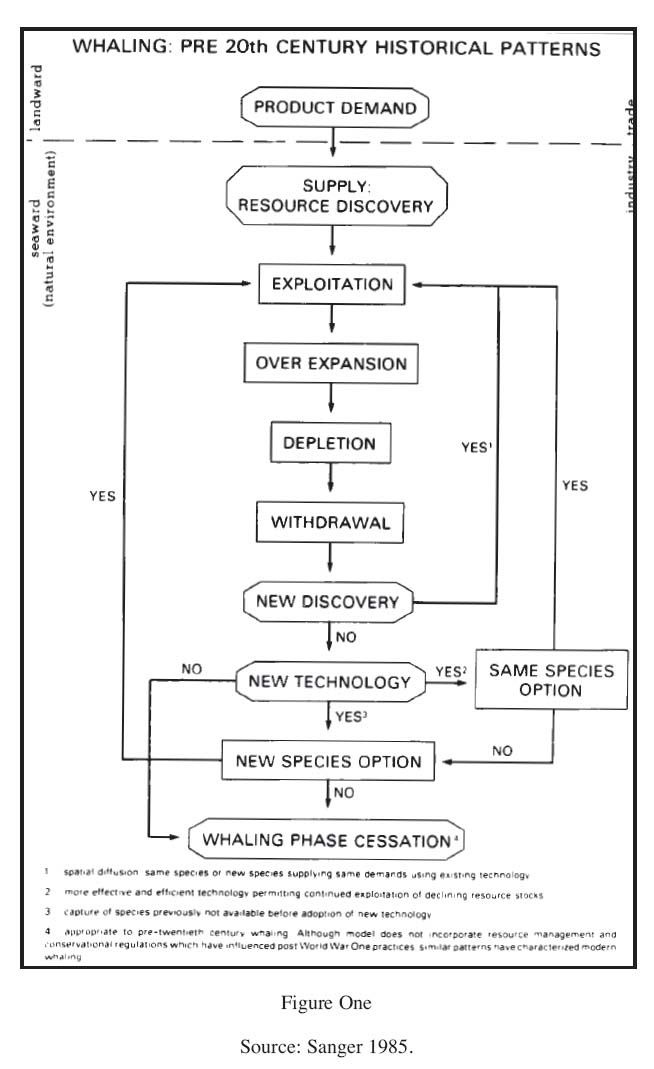
Display large image of Figure 1
3 In the beginning, open boats and hand thrown harpoons were used to hunt ‘right’ whales which were timid, slow moving, floated when killed and provided large quantities of meat, blubber and baleen. Equipment, skills and strategies developed to permit the capture of black and Greenland right whales were used subsequently to pursue and kill sperm whales.3 ‘Traditional’ whaling ended at the beginning of the present century when Americans stopped bowhead whaling in the Beaufort Sea and the Scots withdrew from the East Greenland and Davis Strait right whale fisheries.4 The successful pursuit of other species of large whales required the development of more sophisticated technology.
4 ‘Modern’ whaling was a Norwegian creation. Between 1864 and 1868, Svend Foyn, originally a Norwegian sealer, developed a system which used a powerful cannon mounted on the bow of a steam-powered catcher to fire an explosive harpoon which was attached to a winching apparatus strong enough to retrieve the very largest rorqual5 (Figure Two). All cetaceans, consequently, now could be hunted commercially. As with the very earliest traditional phase of whaling, hunting first was restricted to coastal waters. Overhunting off Finmark quickly forced Norwegian entrepreneurs to look elsewhere for unexploited stocks, leading first to the construction of shore-stations in Iceland (1883) and then the Faeroe Islands (1894).6 Newfoundland was an obvious target for further westward growth;7 stocks appeared abundant and Adolph Neilsen, a Norwegian with a good knowledge of whaling, had been appointed Superintendent of the newly created Newfoundland Department of Fisheries in 1893.8
5 The significance of the Newfoundland and Labrador phase of modern whaling, in terms of American cetologists and museum curators, is the fact that for the first time they had relatively easy access to whale specimens. Equally important, however, was the quick action of individuals within both the local whaling industry and the international scientific community to take advantage of what was a relatively short window of opportunity before modern whaling, as in the earlier traditional period, became fully pelagic and restricted increasingly to the Southern hemisphere.
6 The modern era of commercial shore-station whaling began in Newfoundland and Labrador with the incorporation on 29 December 1896 of the Cabot Steam Whaling Co. Ltd., a Newfoundland-Norwegian joint venture. A factory was built at Snook’s Arm (Figure Three) in the spring of 1898, and the company took delivery of a new Norwegian-built catcher, the Cabot (Figure Four). Operating off St. John’s, the Cabot killed the first of 91 whales processed in Newfoundland on 26 June of the same year.9 The company later opened a second factory at Balaena on the Island’s south coast to take advantage of seasonal variations in the annual appearance of different whale species.10 Altogether, a total of 21 stations were built around the coast of Newfoundland and Labrador (Figure Five). Due primarily to seriously reduced stocks, the development of Southern hemispheric pelagic whaling and wildly fluctuating oil prices, the Newfoundland industry continued sporadically and at a significantly reduced level11 until 1972 when worldwide concern about the status of whale stocks led Canada to place a moratorium on commercial whaling12 (Figure Six).
Figure Two : Modern Whaling Technology: Originally Developed by Svend Foyn.

Display large image of Figure 2

Display large image of Figure 3

Display large image of Figure 4
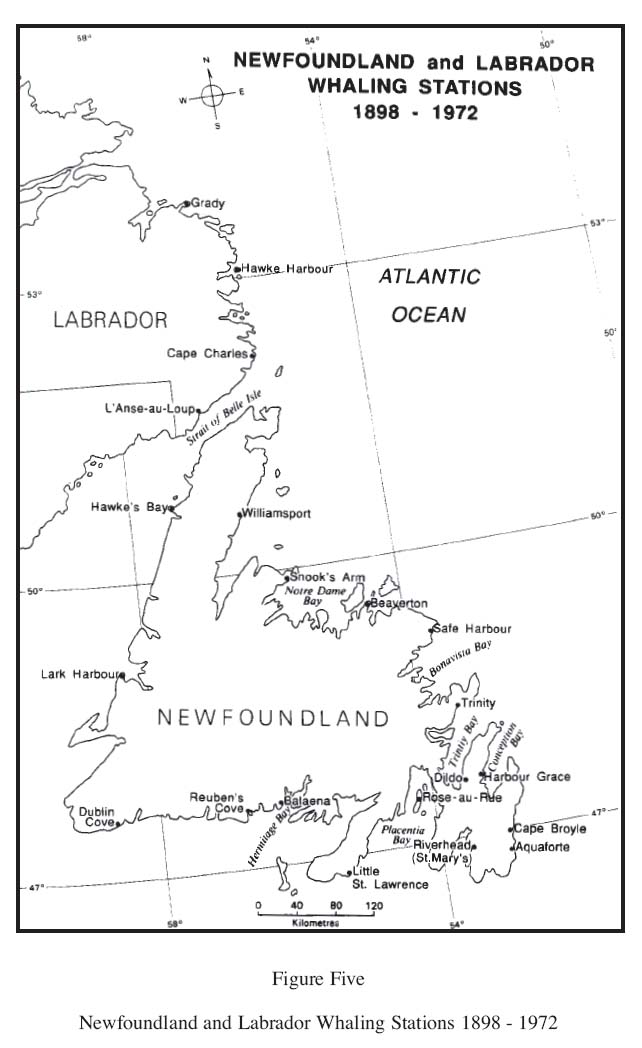
Display large image of Figure 5
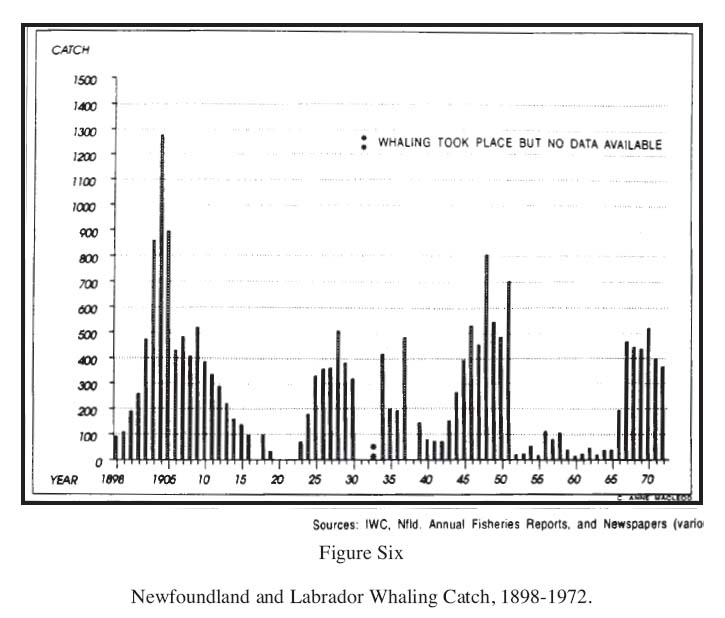
Display large image of Figure 6
7 The location of this new whaling industry on the north-east coast of North America immediately attracted the attention of American marine biologists. Within the first six years, for example, no fewer than five prominent marine biologists from the Smithsonian Institution, the American Museum of Natural History and Harvard University visited several of the new factories. Foremost among these was Dr. Frederick W. True, Head Curator of Biology at the Smithsonian Institution in Washington, D.C., and a specialist in the study of cetaceans and related groups.13 True visited the Snook’s Arm station in the summer of 1899 and set in motion a series of events which ultimately linked the fledgling Newfoundland industry to the award winning American exhibition approved for the 1904 "Louisiana Purchase" World Exposition in St. Louis. The Smithsonian’s principal exhibit, a full-scale model constructed from the skeleton and plaster moulds of a Blue whale captured and processed at Balaena in 1903, was subsequently displayed at the Institution (1905).
8 Following his appointment, in 1881, to the United States National Museum, Smithsonian Institution, Frederick True had begun "a study of the species of whalebone whales which frequent the western North Atlantic, with a view of ascertaining the facts regarding their distribution and migrations".14 During the next decade and a half progress on the project was slow, the result, he would later explain, of his being "so situated as to be unable to work on specimens".15 The opening of the Snook’s Arm station, however, provided an unprecedented opportunity to study the larger cetaceans.16 True’s excitement at the prospect was clear:I discovered a short time ago what appears to be an exceptional opportunity to study whales at a station in Newfoundland, and as these chances do not come more than once or twice in a lifetime, I felt compelled to take advantage of this one if possible. I have written to the Whaling Company to know if their offer holds good, but unfortunately have not had a reply up to this time, as I hoped would be the case.17
9 True’s contact was Dr. Ludwig Rissmuller, an American chemical engineer, who had arrived in Newfoundland in 1899.18 Rissmuller had developed methods for making ‘guano’ from dried and ground fish offal which was sold as chicken feed and cattle fodder.19 He quickly recognized the potential for adapting his methods to the processing of discarded whale carcasses which had become a serious threat to the inshore fishery and a pollution problem for communities immediately adjacent to the new whaling stations.20 Rissmuller soon became involved in virtually all aspects of Newfoundland shore-station whaling.21 Thus, True, with Rissmuller’s "enthusiastic forwarding of [his] desires in the matter of obtaining information and specimens",22 received a favourable reply from the Cabot Steam Whaling Co. Ltd. at the end of May 1899.23
10 With the full support of the Smithsonian,24 True arrived in Snook’s Arm on 30 July 1899.25 Throughout the early part of August he was on the Company’s catcher, Cabot, "engaged in chasing whales in the unquiet waters of Notre Dame Bay".26 He had, moreover, brought along a camera, for the establishment of a shore-based commercial whaling industry in North America coincided with the early use of photography to help illustrate animal behaviour in the wild. Thus, between 4 and 22 August, True was able not only to observe first-hand, but also to photograph, the pursuit, capture and processing of 28 whalebone whales.27 Prior to the turn of the 20th century, whale researchers, as he pointed out in 1903, "had to content themselves with drawings, and as these were quite commonly the work of unskilled hands, they were often extremely inaccurate, or even positively worthless as illustrations".28
11 The trip to Newfoundland proved so productive that True immediately made plans for another expedition. Two years later he visited the Cabot Steam Whaling Co. Ltd.’s newly constructed station at Balaena (Figures Five and Seven) from which the Cabot captured no less than 108 of the 210 whales taken during the early stages of a rapidly expanding industry.29 Not surprisingly, then, True’s stay at Balaena was just as successful as his earlier visit to Snook’s Arm. He was able to examine 25 Blue whales between 20 June and 8 July,30 and to take additional photographs which, as indicated in his comments to a potential publisher in 1904, were still considered a rarity:Of course, you understand that these photographs do not profess to be works of art, but are important and interesting on account of their novelty and the difficulty of obtaining such views.31
12 Besides having an opportunity to observe first-hand the operation of the whaling stations at Snook’s Arm and Balaena, True also participated in the off-shore pursuit and capture of numerous whales. Altogether, he examined approximately fifty whales and took several hundred photographs of both living and dead specimens.32 This data, together with information he had collected previously, resulted in the publication of numerous articles and scientific papers,33 presentations at conferences, and the production of a major monograph.34 With the full cooperation of Cabot Steam Whaling Company personnel at Snook’s Arm and Balaena, then, True was able both to increase the scientific understanding of large whales and to enhance his reputation as the leading cetologist in North America.
Figure Seven : Balaena Whaling Station, 1901.

Display large image of Figure 7
13 True’s 1901 visit to Balaena also had important implications for the development of the Blue whale display being considered for the St. Louis Exposition. Not only was True deeply involved with the organization of the World Fair, but his recent experiences in Newfoundland coincided with changes which were occurring within the Smithsonian and other major American museums during the latter half of the 19th century.35 Whereas, previously, ‘amusement’ was considered a museum’s dominant function,36 by 1900 "the essence of the [new] concept involved organizing museums around a dual purpose: research and popular education".37 Furthermore, in an effort to give the layman a better understanding "of the kingdom of nature, only the best specimens were to be displayed".38 ‘Best’ included the very largest specimens of huge animals such as elephants and whales, and were intended to both attract and amaze visitors.39 The philosophical footings of both museums and World Fairs at the turn of the 20th century, therefore, ensured that education would be a principal theme of the exposition scheduled for St. Louis in 1904. While commenting on its potential value to the general public and academic researchers, for example, William F. Slocum, president of Colorado College, noted that the World Fair embodied "as perfect an illustration as has been seen of the method of the ‘University of the Future’, which is to exchange pictures and living objects for text-books, and to make these, with the aid of laboratory work, the means whereby instruction is given and individual development [is] obtained".40 The construction and display of a full-scale model of a Blue whale (previously not possible) thus offered an unprecedented opportunity to achieve these goals and at the same time embellish America’s image as host nation.
14 The U.S. Congress "appropriated $450,000 toward the erection of a Government building and $800,000 for the preparation and installation of an exhibit by the several departments and bureaus of the Government".41 Frederick True, the Smithsonian’s Head Curator of Biology and a man who had "long experience in exposition work", was appointed to represent the Smithsonian Institution and the National Museum on the Government Board of Management.42 Blue whales had been plentiful at Balaena in June 1901, and, during his visit to the station, True had made arrangements for obtaining a skeleton of one of these large whales at a later date.43 Back in Washington, True successfully argued that a full-scale model of the largest animal in existence should be the centrepiece of the Smithsonian’s contribution to the American display at St. Louis.44 Plans were immediately made to obtain the necessary skeleton, measurements and moulds from Newfoundland.
15 On 7 October 1902 True notified S.P. Langley, Secretary of the Smithsonian, that the time had "arrived when it is necessary to begin preparation for participation in the St. Louis Exposition".45 As part of these preparations, True made arrangements through his Newfoundland connections for his principal assistant at the Smithsonian, Dr. Frederic Augustus Lucas, "to secure the cast and skeleton of a fully grown blue or sulphur-bottom whale".46 Lucas was 51 years old in 1903. Born in Plymouth, Massachusetts, he, as a young man, "was taken by his father, a clipper ship captain, to the ends of the earth".47 This gave him an interest in natural history which he later pursued formally through studies at Ward’s Natural Science Establishment in Rochester, New York.
16 Henry Ward was the most important of several itinerant natural history dealers who pioneered new museum techniques and methods for displaying specimens towards the end of the 19th century. That True was able to argue successfully for the construction of a Blue whale model as the centrepiece of the Smithsonian display at St. Louis depended primarily "upon the remarkable advances in taxidermy realized at Ward’s".48 Moreover, the generally progressive outlook and path-breaking activities of United States’ museums, at least in terms of the preservation and display of large specimens, was due mainly to curators, such as Lucas, who had trained under Henry Ward.49 From Ward’s, Lucas had gone directly to work at the National Museum in Washington.
17 In the spring of 1903, Lucas, William Palmer and J.W. Stollick, all members of the Museum staff,50 arrived at the Balaena whaling station on Newfoundland’s south coast.51 Lucas and his team stayed nearly two months52 and were "entirely successful, returning with a perfect skeleton of a specimen measuring about 78 feet long, and with the moulds of the exterior, from which a cast of the entire animal will be made".53 The responsibility had caused Lucas considerable stress, as he would recall almost 30 years later:The worst part of this work was the fear of failure, the worry lest we did not get a good big whale, and there were some anxious days when no sulphur-bottoms were taken or even seen. We had been assured that whales eighty or more feet long were caught at Balena [sic] and when we measured whale after whale and nothing over seventy-five feet turned up, and few of that length even, there was cause for anxiety.54
18 Ludwig Rissmuller arranged for the Blue whale to be donated by the Cabot Steam Whaling Co. Ltd.55 and, with the help of three employees of his guano factory, the Colonial Manufacturing Co.,56 the skeleton and casts were packaged in 33 crates for shipment by sea to New York.57 The details are provided in a report carried by a St. John’s newspaper:The American Scientists who were at Balena [sic] to make a plaster cast of a whale for the National Museum at Washington, returned by the Glencoe to-day, having had the fullest success in their mission. They secured a splendid "bull" fish, a sulphur-bottom, 78 feet long and weighing about 70 tons. They made a cast of this, and then, after stripping off the flesh, cleaned the skeleton and brought it with them also. The frame of the head is 10 x 9 feet and weighs 3 tons. It is in one package, which is so big that it could not be put in the Glencoe’s hold and had to be carried on her deck the whole way here.58The total cost of the expedition, including transportation, subsistence and wages, amounted to $1,815.89.59
19 Back in Washington, Lucas made inquiries concerning the assembly of the skeleton and the construction of a full-scale model. F.C. Richardson of the Milwaukee Paper Mache Works, for example, informed him that he was "not afraid to tackle a large whale provided the Government can pay for it".60 Not surprisingly, however, given both its fine reputation and Lucas’ early training and professional connections, the contract was awarded to Ward’s Natural Science Establishment "as per proposal of Jan. 6, 1904".61 At a charge of $895.56, Ward’s mounted the skeleton of the sulphur-bottom whale including skull and jaws, repaired broken bones and undertook the papier mâché work, applied the necessary iron standards, and packed and boxed the model for delivery to the Exposition.62 Cleaning, tools, materials and transportation expenses brought the total cost to $1,342.10.63
20 The American exhibit at the St. Louis Exposition was viewed by the Smithsonian as a huge success, having "much more than justified the effort".64 Altogether the individual displays won 15 awards.65 Yet because of the difficulties involved and the expenses incurred, it was an effort which True predicted would not soon be replicated:The size of the whalebone whales, the large expense involved in preparing specimens for scientific purposes, and the large amount of space such specimens occupy, render it improbable that extensive series of specimens will ever be assembled as is the practice nowadays with small mammals.66The impressive life-sized model captured the public’s imagination and served to stimulate a new interest in whales, however. Besides increasing the scientific knowledge of whalebone whales, the early work of True and Lucas in Newfoundland, and the subsequent Fair and museum exhibitions, significantly enhanced the general understanding and appreciation of these species.
21 The unprecedented level of interest in whales generated by the St. Louis Exposition did not end with the close of the World Fair. The substantial financial support which had been provided by the American government, for example, enabled the planned transfer of the Blue whale exhibit to the National Museum to go ahead, and, in their Annual Report for 1905, the Museum’s Board of Regents noted that "the cast, appropriately coloured, is now suspended from steel trusses connected with the framework of the roof in the mammal hall. The skeleton was at the close of the year being installed in the adjoining hall of osteology".67 Nor did the amount of attention generated by the Smithsonian Blue whale model and skeleton go unnoticed by other museums.
22 Frederic Lucas left the Smithsonian Institution to become Curator-in-Chief of the Museums of the Brooklyn Institute of Arts and Sciences in 1904, "the day after the skeleton of the big Blue Whale was put in place".68 His two-month stay at Balaena during the previous summer, and the success of his exhibit at the St. Louis World Fair, had a significant impact on the final phase of his career which was now based almost exclusively upon his "wide knowledge of the larger cetaceans".69 Two decades later, for example, Sir Sidney Harmer, one of the leading whale experts of the inter-war period, wrote Lucas requesting information for his presidential address on the history of whaling which he was preparing for presentation at the annual meetings of the Linnean Society in London.70 In reply, Lucas sent him "a copy of the somewhat detailed measurements that I took of a blue whale at Balana [sic], which you may find of interest".71
23 It is thus not surprising that Lucas, as Chief Curator of a "sister institution",72 provided "invaluable service"73 when the Smithsonian Institution’s arch rival, the American Museum of Natural History, decided, in 1905, to build its own life-size model of a Sulphur-bottom Whale.74 Under the overall supervision of James L. Clark, and with the assistance of a youthful Roy Chapman Andrews (Figure Eight), about to embark on a career which would make him one of America’s most celebrated natural scientists,75 construction of the model was well under way by the early part of 1906. Primarily using measurements, sketches, slides and photographs brought back from Newfoundland by Lucas, Clark set out to construct a far more substantial replica than that made by the Smithsonian Institution.
24 An iron skeleton, to which timber cross sections were attached (Figure Eight), was first assembled in the main display hall (Figure Nine). The entire frame was then sheathed with wooden strips of varying sizes (Figure Ten) and wire netting, before being covered with papier mâché and painted76 (Figure Eleven). Clark took advantage of Lucas’ experience and close proximity, persuading him to become directly involved in all phases of construction.77 In February 1907, for example, Lucas informed the team that he "had expected to have been over last week to take a look at the model".78 The opening of the new display in 1907 received wide publicity.79
25 A conjunction of factors at the turn of the century, then, made the construction of a full-size Blue whale model possible for the first time. These included the availability of specimens, an accommodating whaling industry and especially the greater emphasis of museums toward educating the general public. Of importance also was the presence in Newfoundland of an American whaling entrepreneur, Dr. Ludwig Rissmuller, who had strong ties with American scientific and museum personnel. The most influential was Dr. Frederick True, Head Curator of biology at the National Museum in Washington, and perhaps the most respected of the first generation of cetologists, who played a pivotal role in the organization of the 1904 St. Louis World Fair. The taxidermic techniques being developed by Henry Ward’s company in Rochester, and that firm’s training of museum curators such as Dr. Frederic Lucas, True’s assistant at the Smithsonian, represent other timely interventions. Another facilitating factor was the financing of the project by the American government. It thus could be argued that the fledgling Newfoundland whaling industry was an essential contributor to the St. Louis World Fair exhibit on whaling and thereby helped lay the groundwork for the growth of public interest in, and the intensive international research effort on, whales and whaling which developed during the inter-war period and continues to the present day.
Figure Eight : Model of Blue Whale under construction (American Museum of Natural History): Roy Chapman Andrews in foreground, 1906.
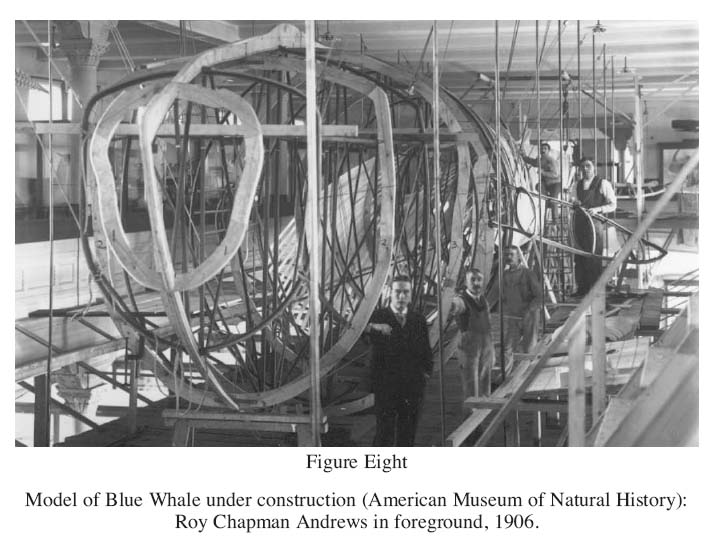
Display large image of Figure 8
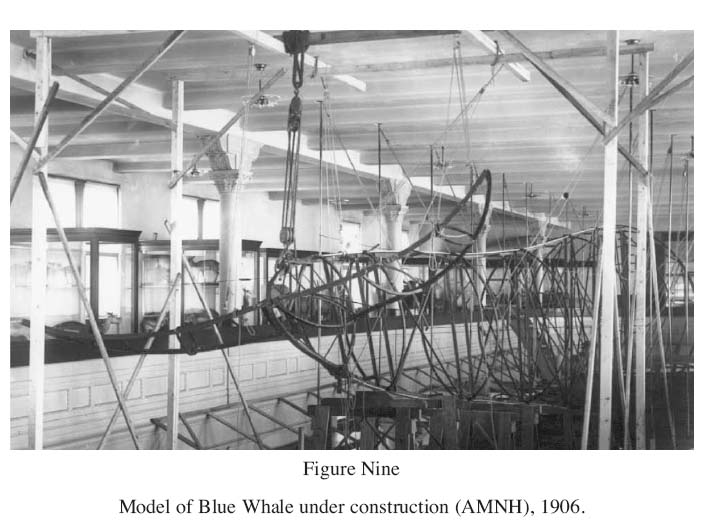
Display large image of Figure 9
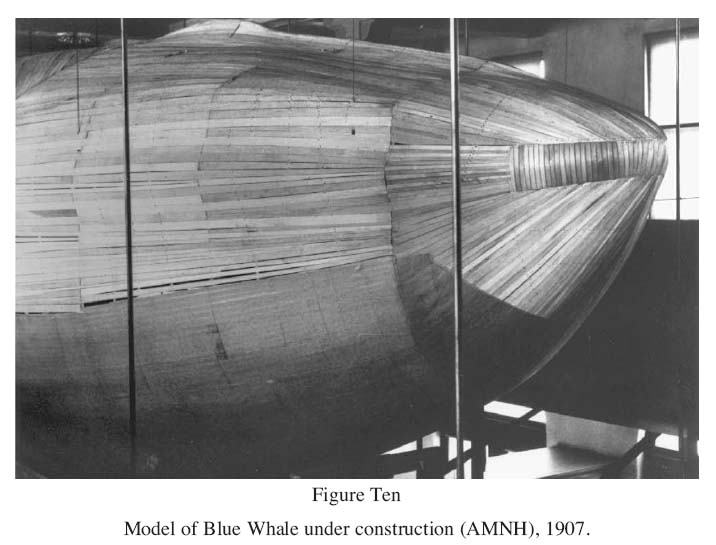
Display large image of Figure 10

Display large image of Figure 11
* The comments and suggestions by Acadiensis’ anonymous reviewers have helped in the revision of this paper. We thank James Mead, Curator of Marine Mammals, Smithsonian Institution, Washington, D.C., and Gordon Handcock, Department of Geography, Memorial University of Newfoundland, St. John’s, for their advice and assistance. We are grateful to the staffs of the American Museum of Natural History Library, New York, N.Y.; Centre for Newfoundland Studies, Queen Elizabeth II Library, Memorial University of Newfoundland; Museum of Comparative Zoology Library, Harvard University, Cambridge, Mass.; Provincial Archives of Newfoundland and Labrador, St. John’s; and Smithsonian Institution Archives. Photographs were provided by the American Museum of Natural History, Provincial Archives of Newfoundland and Labrador, and National Museum of Natural History, Smithsonian Institution. Particular thanks are also due to Gary McManus and Charles Conway, Memorial University of Newfoundland Cartography Laboratory, Department of Geography, Memorial University, and Anne MacLeod, Anigraph Productions Limited, St. John’s, for drawing the figures, and Sharon Wall, General Office, Science Building, Memorial University of Newfoundland, for typing the manuscript. This research was funded by the Social Sciences and Humanities Research Council of Canada and the Institute of Social and Economic Research, Memorial University of Newfoundland.
Notes